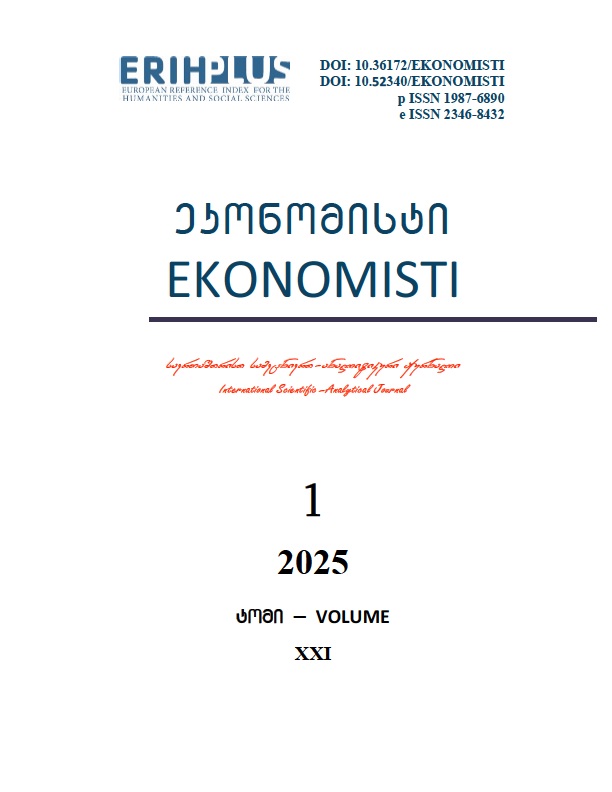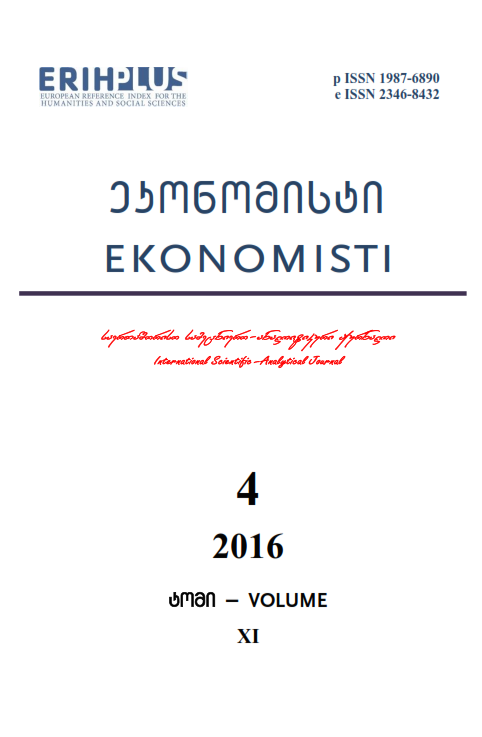
The international scientific and analytical, reviewed, printing and electronic journal of Paata Gugushvili Institute of Economics of Ivane Javakhishvili Tbilisi State University

THE FORMATION OF ECONOMIC MECHANISMS OF ATTRACTION OF FREE FINANCIAL RESOURCES OF NATIONAL BUSINESSES TO ESTABLISH INDUSTRIES IN RELEVANT SECTORS OF THE ECONOMY
Expanded Summary
At very low investment activity of domestic business in Georgia is actually pursued a course for excessive (more than necessary) attraction of foreign investment, both expedient or inappropriate. This entails a brief one-time positive macroeconomic effects (by increasing the flows of foreign currency, the number of jobs), but in the medium and long term aspects it (the excessive number of foreign enterprises) will have detrimental impact on macroeconomic parameters, will increase the country's level of poverty. After all, foreign companies will export all profits from the country in hard currency, and with the abolition of the profit tax of the enterprises the budget will be replenished weakly at the expense of their functioning (though somewhat lower will be the level of unemployment and the budget will receive income tax collected from the employees of these enterprises).
The attraction of a significant scale of funding of national business for new investment construction requires the existence of effective financial development institutions (funds, banks) in the country.
As known, in Georgia, was created the co-investment Fund. It was assumed that national big business would put the funds to co-fund the construction of well-grounded projects, which was very easy to do by a big business with minimal a tax rate of profit (15%). But big business, with the exception of Bidzina Ivanishvili (the funds of which were aimed at the implementation of several major projects), is in no hurry to actively participate in this Fund.
Instead, the profits of large corporations are exchanged in the country for hard currency and in the form of investments sent abroad (especially in offshore areas). Most experts agree that such flight of capital from Georgia reinforces the devaluation tendencies, i.e., affects the stability of lari exchange rate.
It should be noted that the large majority of wealth is created in Georgia through the realization in the country of imported products. Naturally, in order to bring in another batch of imported products is income received in lari must be exchanged for dollars or other hard currency. But in addition, when companies are beginning to exchange the profits into dollars and send them for "investment" abroad, in the country there is an excessive demand for dollars and euros and, as a result, the lari exchange rate becomes unstable, i.e., this is very damaging to the preservation of macroeconomic stability.
Now on state financial development institutions. Even before coming to power of a new government in Georgia there was a "Partnership Fund", a portfolio of assets of which includes several large public corporations. But when you consider that serious enough resources are mobilized, it is obvious that this Fund was not used advantageously, as a small number of objects was built (while control over the expenditure of this public Fund is not established, and for all this there is a cumbersome bureaucratic management structure). Eventually came to the agreement on the creation of "State development Corporation of Georgia" on the basis of Partnership Fund.
Thus, the country faces the daunting task of attracting free resources of national capital in investment to create actual manufacturing in various sectors and subsectors of the economy. To implement this task it is necessary to appropriately reform the major financial institutions of development – 1. Georgian state Corporation, 2. the co-investment Fund and 3. banks and other financial institutions as part of PPG (reforming first of all should be directed on the improvement of mechanisms of attraction of financial resources of the national capital in financial development institutions and of mechanisms to use these funds for investment).
First. How to mobilize the receipt of sufficient funds from national capital in the State Corporation of Georgia?
First of all consider whether the country is offered "the Estonian model of tax reform". For this we compare the tax burden on the profits of businesses in Georgia with similar indexes for other countries.
According to the method used by the experts of PwC and the world Bank in international comparisons of the tax burden, this load is calculated as the ratio of the average amount of taxes paid by hypothetical companies to their total profit. This method takes into account only taxes paid by the enterprises or employer, and represents a tax burden on profits (profit taxes, labour taxes (e.g. social tax paid by employer) and other taxes).
Georgia, even before the introduction of "Estonian version", was among the countries with the lowest tax burden on profits of enterprises. This load in Georgia is even less than in the countries which in one way or another are free economic zones (Singapore, Cyprus offshore). And as for Estonia, according to the largest tax burden on profit of enterprises it ranks among the world leaders, ahead of even Russia and Germany, not to mention all the other neighboring countries (Latvia, Lithuania, Finland). So, the tax burden on the profit of enterprises in Estonia is 3 times higher than the tax burden in Georgia (49.4% vs. 16.4%). Why is there such a difference in tax load on profit of enterprises between Georgia and Estonia? The fact is that in Estonia the employer pays the social tax, the amount of which is also considered as the tax burden on business profits . In view of this circumstance, the tax burden on profits in Estonia is very high, but in Georgia labor taxes paid by the employer does not exist . Thus in Georgia enters not Estonian version of the tax, but something very strange, uncharacteristic even for free economic zones. So claiming that the Estonian version of the tax is introduced, the government does not accurately inform the public, led by the requirements of the destructive part of big business.
Therefore, to replenish the funds of the development Corporation of Georgia (through the relevant articles of the budget expenditures) at the expense of national financial resources of the private sector and in order to properly replenish the state budget it is necessary to increase the rates of some taxes, re-enter the social tax paid by employer, to introduce a progressive rate of income tax (only in March 2015, the head of the IMF mission Mark Griffiths recommended to increase certain taxes in order to limit the budget deficit). In the Corporation's bylaws should clearly be indicated that the main focus of his activities is the investment in construction of enterprises in the real sector of the economy. Now is very sharp the problem of a budding business. There are experienced managers, professionals who till the post-Soviet collapse of the economy worked in the real sector. Therefore, the main activity of the state financial development institution at this stage should be the identification of capable persons who are likely to make a significant contribution to the process of sectoral restructuring of the economy and provide the necessary financial, advisory and other support for the establishment of import-substituting and export-oriented enterprises in the real sector of the economy.
When creating mechanisms to regulate investment activity of state Corporation you can use the experience of some European countries, such as Italy, where there are state holding companies (i.e., in fact, public corporations) – the Institute for reconstruction of industry (IRI), the Management of equity participations and financing of manufacturing industry and others, structured as FIG. But if in Italy, the state holdings such as IRI, were bought by private enterprises, and then upgraded them (later, sometimes, by selling shares, but leaving the controlling stake with them), in Georgia as in the country with the transformation economy, where there were lost many useful production, before the Corporation first and foremost task is to direct their funds to the construction of completely new facilities.
Second. The second possibility to increase the financial capacity for investment in order to create topical productions, primarily at the expense of income from profits of national business – is proper organization of the co-investment Fund, which needs to be converted into an investment Fund similar to that existing in the U.S., with equity participation in the authorized capital of the participants, accumulating the funds in this Fund (i.e. convert it to a pure market structure) with the right of partners to decide the direction of investing in specific projects. The Fund should create a small organization to promote the choice and implementation of technologies in the necessary industry. The principles of operation of the Fund should be needed on the legislation. And in the country, staying in a transformational period in which businesses are reluctant to invest available funds in investment projects within the country, preferring to store them abroad, it is necessary to temporarily establish mandatory deductions from profits of big business to the Fund. Thus, the Fund must also limit the participation of foreign investors. Enterprises built with the participation of the Fund should be predominantly owned by domestic capital, and for construction and initial commissioning of the technology to attract foreign contractor in case of need, such as, for example, provided for the construction of Nenskra HEPs, although the investor in this case too, is foreign (then what is the participation of the partnership Fund?).
Third. You need to create a financial-industrial group (FIG), the presence of which is characteristic of all developed countries with market-oriented financial system (US, UK) and Bank-oriented financial systems (continental Europe, Japan, South Korea) as well. The creation of the FPG is the most reliable and sure way to ensure sustainable economic development of the country.
It is clear that in Georgia, as a small country, it is difficult to create financial-industrial groups with highly specialized set of industrial enterprises, due to the narrowness of financial resources is required a broader range of enterprises. But to create a FIG is imperative and the banks included in the FIG, at this stage of development of Georgia should take responsibility for the coordination and partial funding of construction of new production facilities in relevant sectors of the economy. But in Georgia there is no currently powerful enough banks for this. It is therefore imperative that rich national companies (in particular, trade as well) increase the financial resources of banks, first, by placing a part of their free financial resources in the statutory Fund of the banks (i.e., become their co-owners), and secondly, by placing in them of free financial resources in the form of deposits. A leading Bank in FIG (or two or three banks) will choose the direction of investment, provide a technical justification of projects that will partially finance the construction of enterprises, and another part of funding should take members of PPG industrial and other enterprises themselves (i.e. they should become co-investors, obtaining the appropriate proportion of the share capital of already constructed enterprises).
Thus, in Georgia it is necessary to prevent this (keep the bulk of the population to permanent poverty) serious mistake such as attracting huge amount of foreign private investments, regardless of whether they meet the criteria of expediency or are inappropriate. Extra money for the restructuring of the industry is better to take from the IMF and the WB (but in this case, the state has to become a co-owner of banks operating investment resources), which, after proper development of the economy will then easily be settled up, given the fact that new enterprises and banks in a timely manner will repay "investment" debts owing to received profit.
Thus, to increase funds of the state Corporation by means of the national capital seems to be necessary to increase tax rates (and re-enter the social tax on employers) and direct the most part obtained at the expense of this amount to the state Corporation, whose principal objective should be investment construction of new production facilities in the public sector. For the revitalization of the co-investment Fund the mechanism for its functioning must be rebuilt in accordance with the laws of the market economy (for example, the principles of functioning of investment institutions of the United States) – this should be purely market-based formations and physical and legal entities contributing to the Fund should have joint-stock shares in it. The engagement of national capital investment project will be promoted by means of creation of FIG. For their creation and functioning in the business environment taking into account existing legislation should be worked out certain principles (in particular on the interaction of financial and industrial capital), and the government should do the coordination work aimed at encouraging the formation of such entities, and strengthening the position of those of commercial banks, investment activity in which occupies a significant place among the entire set of activities.

